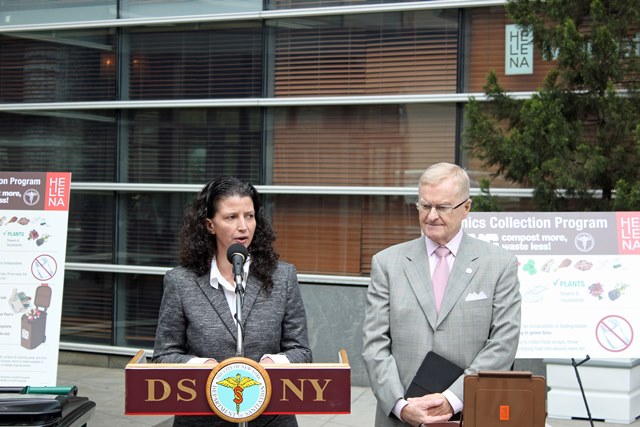NYC’s First Apartment Building Composting Program Unveiled
The Helena apartment building on Manhattan’s West Side is the first in New York City to offer residents regular food scrap collection through the city’s Organics Collection Program, according to The New York City Department of Sanitation (DSNY) and The Durst Organization.
By Jeffrey Steele, Contributing Writer
The Helena apartment building on Manhattan’s West Side is the first in New York City to offer residents regular food scrap collection through the city’s Organics Collection Program, according to The New York City Department of Sanitation (DSNY) and The Durst Organization.
The program helps the city reduce trash disposal costs, achieve its recycling goals and limit greenhouse gas emissions by removing from the trash stream and recycling such organic materials as food scraps, soiled paper and plants.
Residents collect their organics in small kitchen containers, depositing them in larger organic collection bins in their floor’s trash room.
The residents of the Helena, located 601 W. 57th St., will divert approximately 35 percent of their waste from landfills to composting facilities.
“This will have tremendous environmental benefits because, instead of the waste being trucked hundreds of miles away, it can compost locally,” said Helena Durst of the Durst Organization.
Recycling compostable materials is very important to her family, Durst adds. Her father was the founder of one of New York’s largest organic farms, and composting was begun at McEnroe Organic more than two decades ago, she says. “DSNY approached us based upon our experience composting in our commercial portfolio,” she added, noting the challenges of implementing the program have been minimal. “The education of our residents has been relatively simple, as are the logistics of collection.”
Items that may be composted include food scraps such as fruits, vegetables, egg shells, pasta, tea bags, coffee grounds and filters, baked goods, meat, bones, flowers, houseplants and soiled tissues, paper towels, napkins and paper plates.
Items that may not be composted include such things as plastics of any kind, liquids, foam items and animal waste, cigarettes and ashes and medical waste.
Once collected, the organics from the Helena building will be combined with organic material collected from some New York City schools and transported to a local DSNY compositing facility.
At that site, it will be processed and eventually transformed into compost that may be used in community gardens, street trees, parks, and neighborhood beautification programs.
“Recycling our organics can have measurable, positive effects on our city and the environment,” said Ron Gonen, DSNY’s deputy commissioner for recycling and sustainability. “Compostable organics make up about a third of our residential waste stream. With residential composting, we have the opportunity to keep these materials out of landfills and help lower our export costs. In addition, those materials will turn to compost, to nourish the trees and plans throughout the city. It’s a win-win proposition.”
This article was written for commercialsearch.com/news and Multi-HousingNews.com
Like us on facebook: https://www.facebook.com/pages/Commercial-Property-Executive/258033884191?fref=ts








You must be logged in to post a comment.